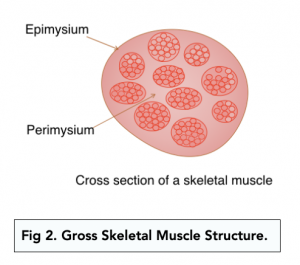The Structure of Mammalian Muscles (A-level Biology)
The Structure of Mammalian Muscles
Skeletal Muscle Structure
Gross Skeletal Muscle Structure
- Muscle tissue is made up of bundles of muscle fibres known as fascicles.
- Each bundle of muscle fibres (fascicles) are surrounded by a layer of connective tissue – the perimysium.
- A final layer of connective tissue that surrounds the perimeter of the muscle fibres – the epimysium.

Microscopic Skeletal Muscle Structure
- Each skeletal muscle is a bundle of millions of muscle cells called fibres.
- Muscle fibres are long, thin cells with many nuclei.
- The dark strips that run along the fibres are called striations and are formed by specialised protein structures called myofibrils that aid contractions.
The components of muscle fibre cells have different names:
-
- Sarcoplasm – the cytoplasm of the muscle cell is called the sarcoplasm
-
- Sarcolemma – the cell membrane of the muscle cell is called the sarcolemma. The sarcolemma folds up on itself to form transverse tubules – these help to transmit electrical impulses very quickly through the whole muscle fibre.
-
- Sarcoplasmic reticulum – the endoplasmic reticulum of the muscle cell is called the sarcoplasmic reticulum. It forms a network of internal membranes that store calcium ions to aid muscle contraction.





Still got a question? Leave a comment
Leave a comment